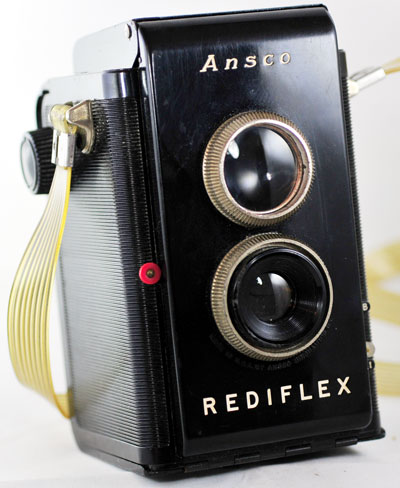Ansco Rediflex
Specification

| Manufacturer | : | Ansco |
|---|---|---|
| Produced | : | 1948 |
| Classification | : | Medium Format |
| Body Type | : | Pseudo Twin Lens Reflex |
| Construction | : | Plastic |
| Film Type | : | 620 |
| Film Width | : | 62mm |
| ImageSize | : | 2¼ x 2¼ in |
| No. of Images | : | 12 |
| Lens Type | : | meniscus |
| Focal Length | : | 70mm |
| Focus Type | : | Fixed |
| Focal Range | : | 6ft - inf. |
| Aperture Type | : | Fixed |
| Aperture | : | f/16 |
| Shutter Type | : | Rotary |
| Shutter Speeds | : | T, I*(1/50sec) |
| Size (w x h x d) | : | 100 x 81 x 70 mm |
| Weight | : | 150g |
| * Measured on this camera | ||
Art Deco Credentials
![]()
![]()
Noteworthy: Worth giving special attention
I consider this camera to warrant 2 stars for the following attributes:
- designed after the main Art Deco period
- plastic body with fine linear raised vertical striped pattern
- silver colour plastic for lens and viewfinder bezels
- ribbed pattern on viewfinder cover
Description
The Ansco Rediflex is a simple child's box camera made by the Ansco camera corporation of Binghamton, New York in about 1948. The camera can be described as a pseudo twin lens reflex camera. It isn't a true TLR because the top lens is just part of the viewfinder and does not aid focussing. The camera produces 12 square photographs on a roll of 620 format film. It features a black plastic body with silver accents around the lenses. The plastic body and metal viewfinder cover has fine ribbing.
This is a twin lens reflex style camera with a large waist level viewfinder. The shutter release has a traditional Ansco red shutter trigger knob. Focal length of the camera is 70 mm and it has an f/16 lens. Focus is fixed and objects from about 6' to infinity are in focus. Film is advanced by a black knob and it uses a red window to control the image spacing. There are no tripod mounts.
Flash synchronisation terminal are provided.
How to Use
Find the manual here:- Agfa Rediflex Manual
This camera takes 620 film which is still available from selected photographic outlets. Although the actual film is the same as 120 film, the spools are different. The 620 spools are slightly shorter and have a smaller diameter. Do not use 120 film in this camera because it will jam and may snap. It is possible to cut down the spool of 120 film to fit or to re-spool some 120 film onto 620 spools in a darkroom or changing bag.
Don't forget to ask for your 620 spool back when getting the film developed.
If you don't want to bother with an exposure meter, follow the guide shown. It is based on the 'Sunny 16' rule. Film is so forgiving and will produce acceptable results even when overexposed by 2 or 3 stops or underexposed by 1 stop.
Remember that the exposure guide in the camera user manual may not be helpful as it is based on the use of old film with a low ISO value.
The table assumes that the sun is at least 30 degrees above the horizon - that's 10am - 5pm on a summer's day in the UK.
This camera has an aperture of f/16 and a shutter speed is 1/50s.
As the shutter speed is only 1/50s, it is advisable to try to hold the camera against a wall or other solid object. For quick snapshots, hold it firmly against your face.
Using ISO 100/125 film - shutter speed 1/50s
| Weather Conditions | Shadow Detail | Aperture | Exposure |
|---|---|---|---|
 Sunny SunnySnow/Sand | Dark with sharp edges | f/16 | +2 Stop Overexposed Acceptable |
 Sunny Sunny | Distinct | f/16 | +1 Stop Overexposed Acceptable |
 Slight Overcast Slight Overcast | Soft around edges | f/16 | Good |
 Overcast Overcast | Barely visible | f/16 | -1 Stop Underexposed Acceptable |
 Heavy Overcast Heavy Overcast | None | f/16 | -2 Stop Underexposed Unacceptable |
 Open Shade Open Shade/Sunset | None | f/16 | -3 Stop Underexposed Unacceptable |